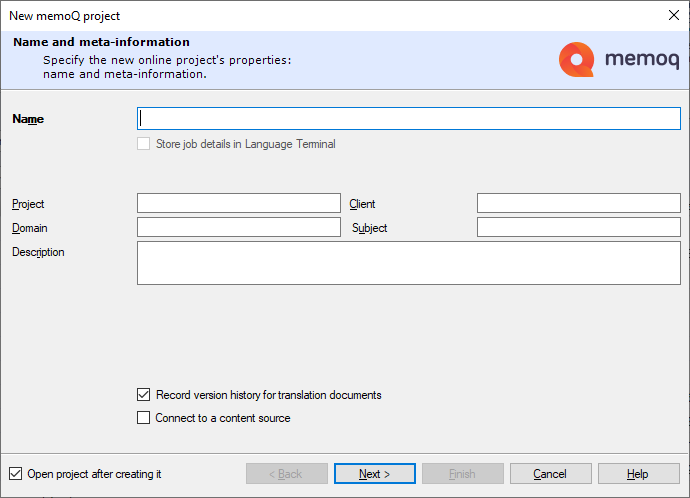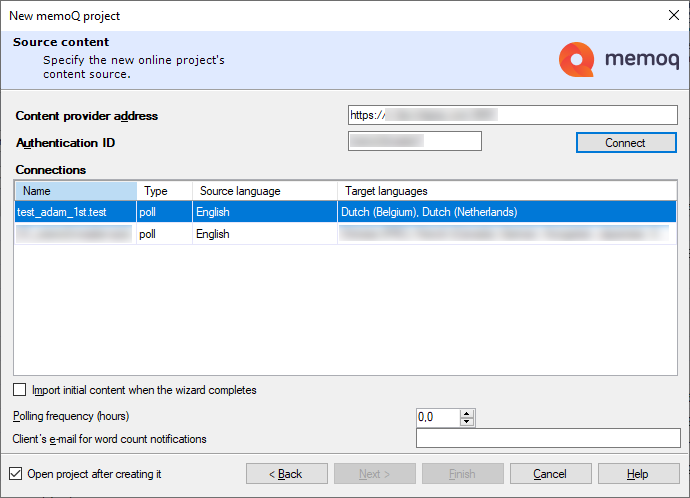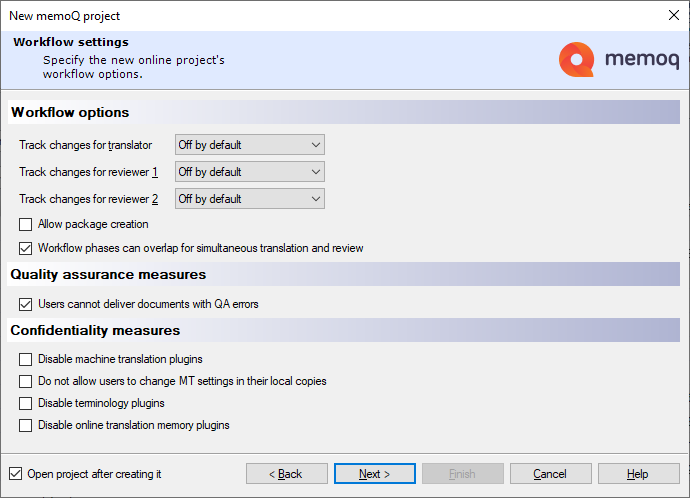New memoQ project (online project)
This wizard helps you create an online project on a memoQ TMS.
Use templates instead: Create your regular projects from templates instead. It takes less time, and helps reusing your resources.
You need the project manager edition of memoQ to manage online projects.
You need to be a project manager or an administrator: You may create online projects only if you are member of the Project managers or Administrators group on the memoQ TMS.
How to get here
In the main memoQ window - the Dashboard -, connect to a memoQ TMS: At the top of the Dashboard, type the address of the server in the text box. Or, choose a server from the drop-down list.
Log in if this is the first time: If you haven't used that memoQ TMS before, the Log in to server window appears. Type your user name and password, or choose another way to log in as needed. On the memoQ TMS, you need Project Manager or Administrator rights.
On the Project ribbon, click New Project, and from the menu, choose New Online Project. The New memoQ project window opens.


What can you do?
Go through the steps of the wizard, specifying the details and settings of the online project.
In the Name field, type a name for the project.
To add more details, fill the Project, Client, Domain, Subject, and Description fields as needed.
Fill in as many details as you can: Later, you can search for these details when you try to find a specific project. The more details you fill in, the easier it will be to find the project.
Don't clear the Record version history for translation documents checkbox: memoQ will track the history of documents and segments in the project. Whenever a change is made to a segment, memoQ records the earlier version, so that you can view the changes, or even to revert to an earlier version. In addition, you can tag your project at a specific time, so that memoQ can always show how the project looked like at the time it was tagged. There is no reason to turn this off, unless you are running very low on free disk space.
Connect to a content source checkbox: Check this if you need memoQ TMS to watch a content source [such as a file folder or a content management system (CMS) on the server itself, or another computer], instead of adding files manually. If this checkbox is selected, and you click Next, memoQ will display the Content source page.
By connecting to a content source, you create a content-connected online project. You cannot add documents manually to a content-connected project. All documents in the project are received from the content source. There is no regular Export command either: when the translation is finished, documents will be sent back to the content source. The content source is always set up with rules that control how documents are imported and exported.
Cannot change the languages in a content-connected project: The languages are configured in the connection that is hosted in the content connector service.
To proceed to the next page: Click Next.
To return to the Dashboard without creating a project: Click Cancel.

Type the address of the content source in the Content provider address box, and if the content source requires an authentication ID (practically, a password), type or paste it in the Authentication ID box. Then click Connect.
memoQ will list the available content sources in the Connections list. Click a content source. Fill the Polling frequency (hours) and Client's e-mail for word count notifications fields.
To start importing from the content source right after you create the online project: Select the Import initial content when the wizard completes checkbox.
To proceed to the next page: Click Next.
To return to the Dashboard without creating a project: Click Cancel.
To go back to the previous page: Click Back.

Select the languages for the project.
From the Source language dropdown, choose the source language.
To add target languages: Click the name of the language in the language list. You can select two or more languages: Click the first language, then press and hold down Ctrl, and click the other languages. Under the list, click Add selected. The selected language appears in the Target languages list on the right. You can also double-click the name of each language.
To find a language: In the Filter list box, start typing the name of the language. memoQ will narrow down the list to the languages that match the characters you typed. For example, if you type 'glish', the list will contain the English language (and its sublanguages) only.
To proceed to the next page: Click Next.
To return to the Dashboard without creating a project: Click Cancel.
To go back to the previous page: Click Back.

Workflow options
Normally, tracking changes is off for all participants, but they can turn it on. Translators do not need if they translate most segments from scratch. But they may need to track their changes if they have matches or machine translation in most segments.
For every role, there are four settings. Use the Track changes for translator, Track changes for reviewer 1, or the Track changes for reviewer 2 dropdown.
- Off by default: This is the default setting. Tracking changes is off, but the translator or reviewer can turn it on.
- On by default: Tracking changes is on, but the translator or reviewer can turn it off.
- Off: Tracking changes is off, and the translator or reviewer cannot turn it on.
- On: Tracking changes is on, and the translator or reviewer cannot turn it off.
If translators and reviewers work on the same document at the same time, clear the Allow package creation checkbox. Or, make sure it's cleared. Select the Workflow phases can overlap for simultaneous translation and review checkbox.
Normally, projects are like this: At first, project templates (and online projects) have this setting. But there is a price: Every user needs to be online all the time while they work on the job.
If translators and reviewers don't work on the same document at the same time - or some users cannot be online all the time: Select the Allow package creation checkbox. (This clears the Workflow phases can overlap for simultaneous translation and review checkbox.) If you allow package creation, users can download handoff packages from the online project. Their memoQ imports the package on their own computer, and they can continue working on the project offline.
Must prepare package creation: Allowing package creation in the online project is not enough. Each user must be allowed to use packages. You can give them permission in their memoQ TMS user account.
Sending work to subvendor groups? Do not use packages: Make sure the Allow package creation checkbox is cleared. Otherwise you will not be able to assign subvendor groups to documents.
Quality assurance measures
If translators need to look at all QA warnings: Select the Users cannot deliver documents with QA errors checkbox. This is the default setting: You need to clear the checkbox if you don't want this. The translator won't be able to click Deliver before all automatic QA warnings are corrected or dismissed.
If reviewers handle QA warnings: Clear the Users cannot deliver documents with QA errors checkbox. Translators can click Deliver, even if there are active QA warnings in a document.
By checking or clearing the checkboxes under Workflow settings, you can answer the following question:
Confidentiality measures
memoQ can use various online resources (machine translation, terminology services, online translation memories) to help with translation. But then memoQ sends complete segments to public websites. If the source material is confidential, this may be a breach of your non-disclosure agreement with your client. You can prevent the translators and reviewers from using these services in that project.
When translating confidential or secret materials: Check the Disable machine translation plugins, Disable terminology plugins, and Disable online translation memory plugins checkboxes. Normally memoQ allows users to use such plugins. But if you check these checkboxes, memoQ on your users' computers will not reach out to those services. If confidentiality is important on a project, turn on these settings together.
Even if materials are not confidential, you may want to prevent the use of such services - for example, to have better control over quality. Select or clear these checkboxes as needed,
To proceed to the next page: Click Next.
To return to the Dashboard without creating a project: Click Cancel.
To go back to the previous page: Click Back.
On this page, you can control what team members can do with documents and resources they check out with this project.

Checkout options
If the network might be slow between the translator and your server, select the Create offline copies of TMs and TBs at checkout checkbox. When the translator checks out the project, memoQ downloads the translation memories and term bases. The checkout will take longer, and the users will need more disk space on their computers - but memoQ will offer suggestions more quickly. Normally, memoQ does not download translation memories and term bases.
LiveDocs corpora are never downloaded.
If you don't want translators or reviewers to create local copies of the project on their own machines, clear the Allow users to check out project checkbox.
Resources in packages
These options only show if you checked the Allow package creation checkbox
For each resource type, you can choose from the same options:
-
Include resource filtered for project: Users can download a minimum-size TM and TB that contain only the entries that are useful for translating the documents in the project. But these TMs and TBs don't include entries that are saved in the 'live' TMs and TBs during the project. And a lot of entries will be missing from the TMs that could be used for concordancing. But the user will have access to the unfiltered TMs and TBs over the network. This is the default choice for TMs and TBs. You cannot choose this for LiveDocs corpora.
-
Include entire resource: All the project's TMs, TBs, or LiveDocs corpora are downloaded with the package. This can be a huge amount of data, taking a long time to download, and occupying a lot of disk space. Choose this only if the network connection between the users and the memoQ TMS is so bad that otherwise they couldn't receive suggestions. This is the default choice for LiveDocs corpora.
-
Link online resource: There won't be any resources of the given type in the package itself. But when you import the project, memoQ will connect to the online translation memories, term bases, and LiveDocs corpora. Translators must be online to receive results. But this package will be the fastest to download, and occupy the least disk space. This is the default choice for Qterm TBs.
Document options
These options normally allow every user to join and split segments; to export the finished or unfinished translation; and to see the preview for each document they downloaded. Most of the time, there is no reason to turn off any of these. Here are a few exceptions:
- If it's important that source segments stay the same in all target languages: Clear the Allow users to join and split segments checkbox. This can be useful in projects with several target languages.
- If the documents are so confidential that you want to prevent users from exporting them on their computers: Clear the Allow users to export translated document and Allow bilingual export from a local copy checkboxes. In this case, you must export every document from the memoQ online project window.
- If you need to minimize the network load when checking out projects: Clear the Use data needed for preview in a local copy checkbox. Translators won't be able to see the built-in preview for the documents they are translating.
Communication
Normally, memoQ allows users to chat and to start discussions in an online project. If, for some reason, you cannot allow this: Clear the Project participants can communicate when online checkbox.
After you complete the wizard, memoQ creates an empty online project on the memoQ TMS.
When you finish
To create the online project on the memoQ TMS: Click Finish.
Continue setting up the project in the memoQ online project window: After the project is created, memoQ will open it for management in the memoQ online project window. (Unless you turn this off in the wizard.) There you can import documents and assign them to participants. You can also add LiveDocs corpora, translation memories, term bases, and other resources. To learn more, see Help about the memoQ online project window.
To return to the Dashboard, and not create a project: Click Cancel.
To go back to the previous page, and change settings: Click Back.
Most of this will happen in the memoQ online project window.
- Import documents into the project. Choose Translations. On the Online Project ribbon, click Import. Or, click the Import label below the Import icon, and choose Import with Options or Import Folder Structure.
- Add translation memories, LiveDocs corpora, and term bases to the project as necessary.
If you need to check the documents (for example, check if the segmentation or pre-translation is correct): Check out a local copy, and do whatever you have to do in the translation editor. The rest happens in the memoQ online project window.
- Add translators and reviewers to the project. To do this, use the People pane of the memoQ online project window.
- Still on the People pane of the memoQ online project window, use the Languages and roles tab to tell memoQ about the role and language pair of each participant.
- On the Translations pane, assign or auto-assign translators and reviewers to each document.
- Finally, launch the project: On the Online Project ribbon, click Launch Project. All participants will receive an e-mail about the work they need to do, and memoQ TMS will start tracking the status of each document.